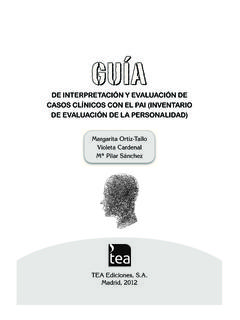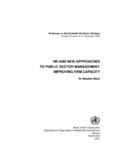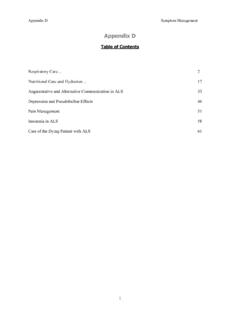Transcription of Original Article PsychometricProperties ...
1 D. Arribas- guila: Psychometric Properties of the TEA Personality TestEuropean Journalof Psychological Assessment20 11; Vol. 27(2):121 126 2011 Hogrefe PublishingOriginal ArticlePsychometric Propertiesof the TEA Personality TestEvidence of Reliability and Construct ValidityDavid Arribas- guilaResearch and Development Department, TEA Ediciones, Madrid, present study examined the psychometric properties of the TEA Personality Test (TPT) in a sample of 23,062 Spanishadults. The TPT is a self-report questionnaire to be answered using afour-point Likert scale to assess personality at work and it is thethird most frequently used tool by work psychologists in Spain. Thereliability and validity analyses indicated that the TPT has adequatepsychometric properties for the Spanish sample analyzed.
2 Ordinal was used to calculate the internal consistency reliability of the were higher than those of Cronbach s reported in the TPT s technical manual (p< .001). Results from confirmatory factoranalyses showed an acceptable goodness-of-fit for the theoretical three factors of the TPT s work personality model reported in thetechnical manual. The findings support the reliability and construct validity of the :TPT, TEA personality test, reliability, construct validityIntroductionIn recent years, there has been a growing tendency in theliterature to examine the psychometric properties of psycho-logical tests, such being the topic of many research studies( , Lenzenweger, Clarkin, Kernberg, & Foelsch, 2001;Tsaousis & Georgiades, 2009; Tsaousis & Kepelis, 2004).
3 Spanish adaptations of tests have also emerged ( , Alonso-Arbiol, Balluerka, Shaver, & Gillath, 2008; Buela-Casal,Carretero-Dios, De los Santos-Roig, & Berm dez, 2003;Garc a, Aluja, & Garc a, 2004; Gom -i-Freixanet, Valero,Punti, & Zuckerman, 2004; M ndez, Hidalgo, & Ingl s,2002; Penley, Wiebe, & Nwosu, 2003; Rintala et al., 2002;Rodr guez Fornells, Lorenzo-Seva, & Andr s-Pueyo, 2001;Ruip rez, Ib nez, Lorente, Moro, & Ortet, 2001). These stud-ies provide relevant scientific evidence to update psychomet-ric data and validity of tests over the most cases, the tests technical manuals provide themost relevant information for their use and , authors and test developers emphasize the needto continue updating the psychometric properties and ex-tending the research on which the test was based during itsdevelopment and standardization (Arribas, Corral, & Pere- a, 2010; Fernandez-Seara, Seisdedos, & Mielgo, 2008;Seisdedos, 2002a, 2002b, 2004a, 2004b, 2008).
4 A system-atic review of psychological tests and their properties ismore widespread in the US than in Europe, and includesregular publications with the sole purpose of reviewingpublished tests (Geisinger, Spies, Carlson, & Plake, 2007).Recently Mu iz and Fernandez-Hermida (2010) con-ducted a study on the most frequently used tests in Spain,using a questionnaire developed by the European Federa-tion of Psychologists Associations (EFPA). Personalityquestionnaires most frequently used by work psychologistswere, in this order: 16PF-5 (Cattell, Cattell, & Cattell,2005), PAPI (Kostick, 1976), TPT (Corral, Pere a, Pamos,& Seisdedos, 2002), IPV (ECPA, 2005), MMPI-2 (Hath-away & McKinley, 2002), BFQ (Caprara, Barbaranelli, &Borgogni, 2005), MCMI-III (Millon, 2007) and NEO PI-R(Costa & McCrae, 2008).
5 It also highlights SOSIA (Gor-don, ECPA, & TEA Ediciones, 2008), BIP (Hossiep & Pa-schen, 2008) and compeTEA (Arribas & Pere a, 2009).The TEA Personality Test (TPT), as the third most fre-quently used personality questionnaire by work psychol-ogists in Spain, has no more psychometric studies thanthose reported in the Original edition and the third revisededition. The technical manual reports the test s reliabilityin terms of Cronbach s , with values ranging from (median = ). Construct validity was studiedusing an exploratory factor analysis (EFA), and its resultssuggest 3 second-order factors: Emotional Stability,Mental Openness, and Responsibility. There is no moreinformation about reliability, construct validity, factorialsolution fitness, or confirmatory theoretical structure inthe the development of the TPT, the study of psycho-metric properties according to classical test theory has beensignificantly improved.
6 In the field of reliability, Cron-DOI: 2011 Hogrefe PublishingEuropean Journal of Psychological Assessment2011; Vol. 27(2):121 126bach s (1951) coefficient is the norm-referenced tech-nique that many researchers have been using to measurethe internal consistency of tests (Cortina, 1993; Zumbo &Rupp, 2004). However, Cronbach s is based on the as-sumption of continuity of the variables and this assumptionis not met by ordinal response items or Likert scales (Elo-s a & Zumbo, 2008). Several studies provide evidence thatCronbach s tends to underestimate the true reliability oftest scores (Drewes, 2000; Nunnally & Bernstein, 1994;Osburn, 2000; Ten Berge & Hofstee, 1999) and shows aspurious decrease in its value when the number of catego-ries in the rating scale is less than five (Lozano, Garc a-Cueto, & Mu iz, 2008; Weng, 2004).
7 An alternative pro-cedure to Cronbach s coefficient is ordinal , based onthe factor analysis of the polychoric correlation matrix(McDonald, 1999; Rupp, Koh, & Zumbo, 2003).Construct validity has been traditionally explored usingEFA, a statistical technique used to explore the possible un-derlying factor structure without imposing a preconceivedstructure on the outcome (Child, 1990). This technique isappropriate during test development, but confirmatory factoranalysis (CFA) is a more powerful alternative that allows theresearcher to postulate the relationship pattern a priori, usingthe knowledge of the theory or empirical research, and testthe hypothesis statistically (J reskog, 1993).
8 The present research is aimed at providing updated evi-dence on the psychometric properties of the TPT in terms ofreliability and construct validity. Reliability of the scales isexplored using the ordinal approach, reliability of the dimen-sions is studied using the continuous factorial approach, andconstruct validity by means of CFA. We expected to replicateand to find better results with regards to reliability and con-struct validity than those reported in the technical manual. Asatisfactory goodness-of-fit of the work personality modelassessed by the TPT was also and MethodSampleComputerized archival data from the Internet Scoring Sys-tem of TEA Ediciones ( ) was used forthis study.
9 The TPT items and raw scores data were collect-ed from 23,062 subjects with ages ranging from 18 to 75(Mean = ;SD= ), assessed in Spain between 2005and 2010. In the sample, were female (n= 9,476)and were male (n= 13,586).InstrumentThe TPT (Corral et al., 2002) is a 160-item self-report ques-tionnaire to be answered using a 4-point Likert scale. Ac-cording to the technical manual, TPT offers three main fac-tor scores or dimensions (EE, Emotional Stability; AM,Mental Openness; and RP, Responsibility) and 15 facets ofpersonality in the workplace: maladjustment (DAJ), anxi-ety (ANS), depression (DEP), stress tolerance (EST), self-concept (ACO), tolerance & flexibility (TOL), adaptationto changes (ADA), interest in other cultures (CUL), avail-ability (DIS), social intelligence (ISO), social integration(INS), teamwork (EQUI), professional self-demanding(PRO), dynamism & activity (DIN), and tenacity & con-stancy (TES).
10 It also includes a validity scale to assess sin-cerity (SIN). The TPT norms are based on a representativesample of 15,509 adults in the work context ( malesand females).Data AnalysisPolychoric matrix correlations of each scale and factorloadings of each item were obtained with MPLUS soft-ware. Ordinal s were then calculated applying McDon-ald s formula (1999, p. 217):(1)where __is the arithmetical mean of factor loadings, __2is the arithmetical mean of the squared factor loadings,andu2is the arithmetical mean of the variable matrix correlations of each second-order dimen-sion and factor loadings of each scale were also obtainedwith MPLUS software. Continuous factorial of di-mensions were also calculated by means of Equation between reliability coefficients were esti-mated with Feldt s equality test with two independent sam-ples (Feldt, 1980).

















